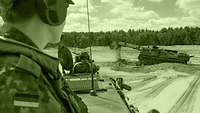German and British Engineers Become One
German and British Engineers Become One
- Date:
- Place:
- Minden
- Reading time:
- 2 MIN
„Good morning!" resounds across the corridor. This will be heard more often in the years to come, since the official working language in the Armoured Engineer Battalion 130 in Minden will soon be English. This is due to the fact the first British officer has been fully integrated into the Battalion Headquarters and the long-planned binational cooperation between the two „armies“ is thus being put into practice
It is nothing new for British and German amphibious engineers to work together. As the binational cooperation of both armies already began in 1972. In 1977, the first joint-exercise called „Neptune’s Trident“ was conducted on the river Elbe near the town of Artlenburg, the exact location where 32 years prior, British tanks crossed the Elbe: a symbol of a past reconciled and moving into the future together. Just as in 2016, when near to the city of Chelmo in Poland, both armies built a 350-meter bridge across the river Weichsel in 34 minutes with their amphibious rigs. Which was a world-record and symbol of 40 years of successful cooperation.
The Joint Vision Statement as the Basis
So why intensify cooperation when it is already working so well? The reason is the “Joint Vision Statement”, which was signed in 2018 by the former Minister of Defence Ursula von der Leyen. Its goal is to have only nations within the NATO to be equipped with the amphibious “M3” bridge system to strengthen cohesion and interoperability, as well as enable them to learn from each other’s experience. This is exactly why now, the decades-old friendship of both armies results in the significantly strengthened teamwork in Minden.
Growing together through Enhanced Teamwork
This enhanced teamwork makes sense, since only in a NATO that is very well interconnected the challenges of the future can successfully be met. As for now, this interconnectedness means the German-British Amphibious Engineer Battalion 130 will include two German and one British amphibious companies. Now that all of the amphibious companies will be under the command of the German battalion commander, the synchronization of both training and exercises will be significantly easier to manage.
NATOs Bridge Builders
What will the future hold for this NATO-wide unique unit? “By the end of the year, four additional British officers will have been integrated into the Headquarters and by 2023 the battalion will be fully operational”, says Lieutenant Colonel Stefan Klein, the commander of the Minden engineers. Obviously there will be multiple obstacles to be cleared, such as the language barrier or the different approaches to handling the M3 rig; however, we are experienced in clearing obstacles: after all, we are engineers and NATOs bridge builders.







